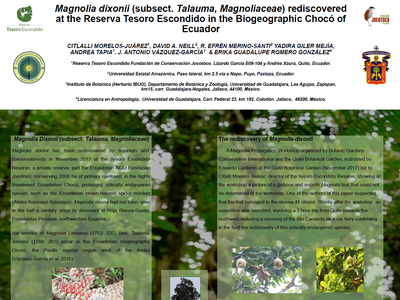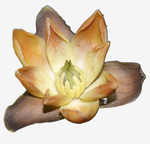Magnolia dixonii (subsect. Talauma, Magnoliaceae) rediscovered at the Reserva Tesoro Escondido in the Biogeographic Chocó of Ecuador
CITLALLI MORELOS-JUÁREZ1, DAVID A. NEILL2, R. EFRÉN MERINO-SANTI2, YADIRA GILER MEJÍA, J. ANTONIO VÁZQUEZ-GARCÍA3 & ERIKA GUADALUPE ROMERO-GONZÁLEZ4
- Reserva Tesoro Escondido Fundación de Conservación Jocotoco. Lizardo García E09-104 y Andrés Xaura, Quito, Ecuador.
- Universidad Estatal Amazónica, Paso lateral, km 2.5 vía a Napo, Puyo, Pastaza, Ecuador.
- Instituto de Botánica (Herbario IBUG), Departamento de Botánica y Zoología, Universidad de Guadalajara, Las Agujas, Zapopan, km15, carr. Guadalajara-Nogales, Jalisco, México.
- Licenciatura en Antropología, Universidad de Guadalajara, CUNORTE, Carretera Federal No. 23, Km. 191, C.P. 46200, Colotlán, Jalisco, México.
A rediscovery of Magnolia dixonii “mamey” took place on November 2017 at the Tesoro Escondido Reserve (Jocotoco Foundation), a reserve conserving 2000 ha of primary rainforest in the highly threatened Ecuadorian Chocó, protecting critically endangered species and their habitat through research, environmental education and community involvement. Magnolia dixonii (subsect. Talauma) had not been seen for half a century since its discovery in Hoja Blanca-Gualpí, Esmeraldas province, NW Ecuador. Then a fruit of M. dixonii was shown at the Magnolia Propagation Workshop in Quito, November 2017, and suspected to be the rediscovery of M. dixonii. A confirmation of the rediscovery of this Critically Endangered species was made in the field by the authors and kickstarted a project to propagate and conserve this tree in the area. Seven trees have been found so far, two of them in pastures and the rest in the primary forest. One-hundred eighty seedlings have been planted in reforestation and key connectivity sites, as well as in local schools as part of a permanent environmental education programme. One-hundred fifty of these seedlings were germinated in soil from the primary forest, taking an average of 47 days to germinate, preferring to grow with available sunlight. Thirty were found as seedlings both in pastures as well as in the primary forest. Myiarchus tuberculifer and Tytira semifacita have been observed feeding from the seeds. Research on demography, predation, pollination and dispersal are underway. The wood of Magnolia dixonii is heavy and has been selectively extracted from several areas, the heavy weight of its wood generates questions about its reported use for building canoes.

